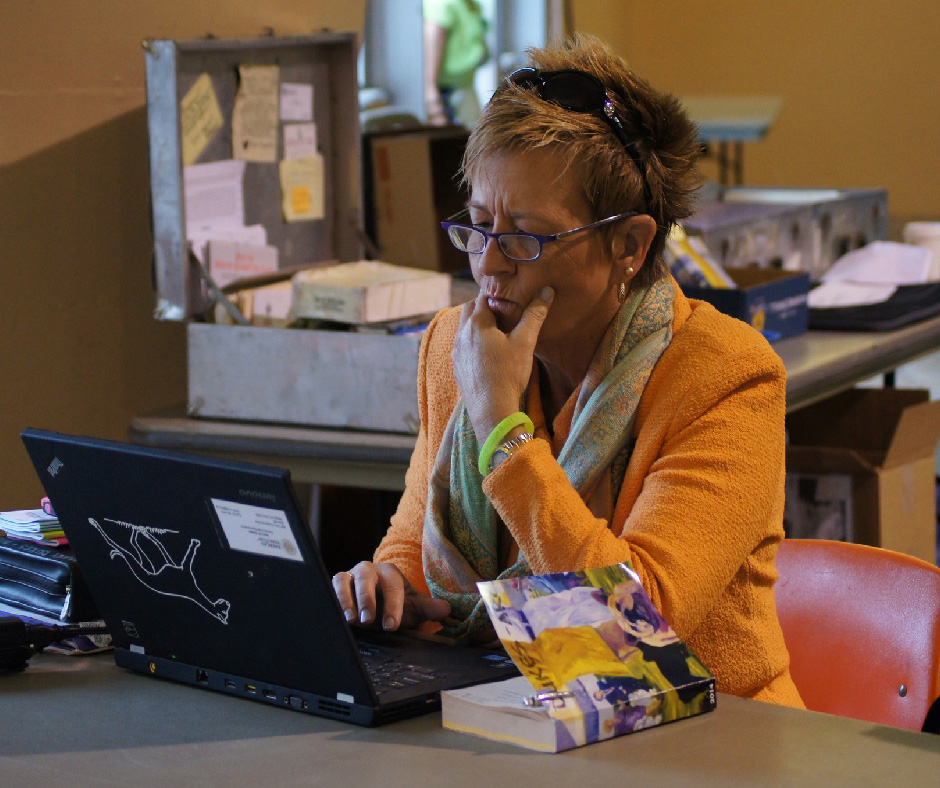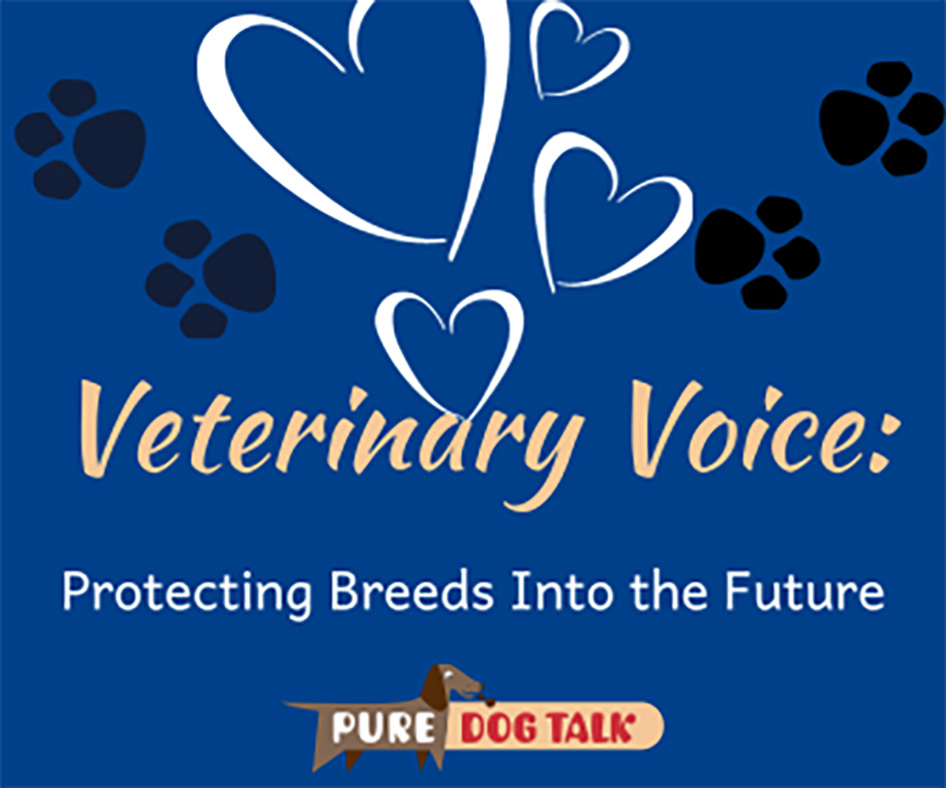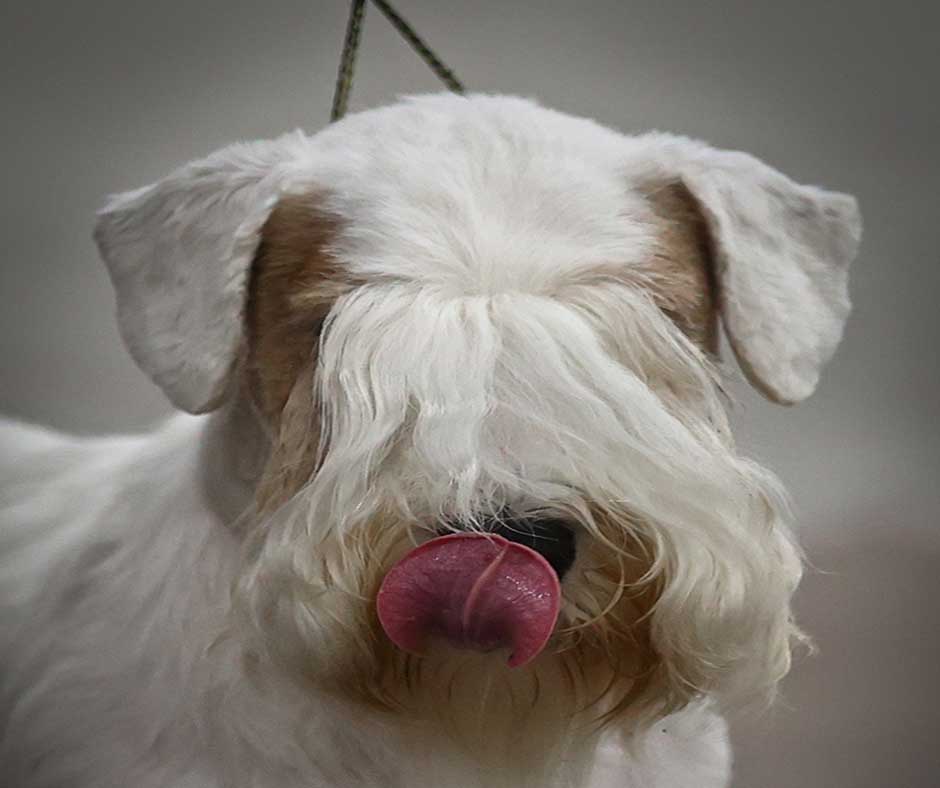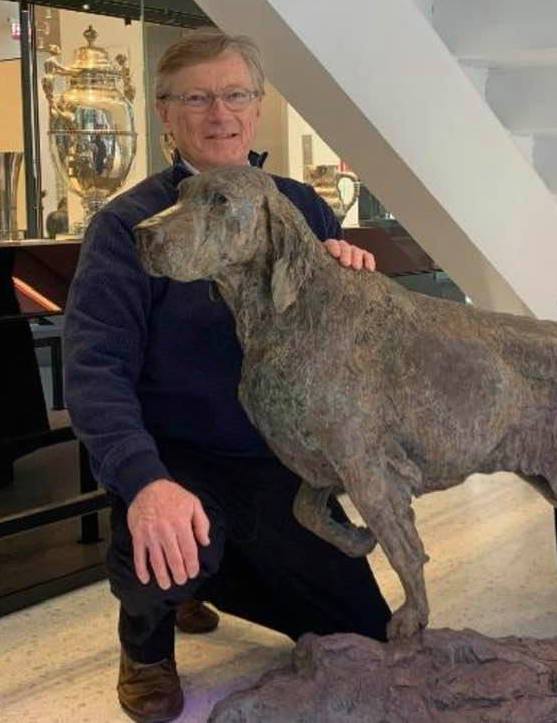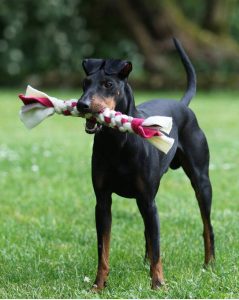680 – Canine Health Foundation Celebrates 30 years
Canine Health Foundation Celebrates 30 years
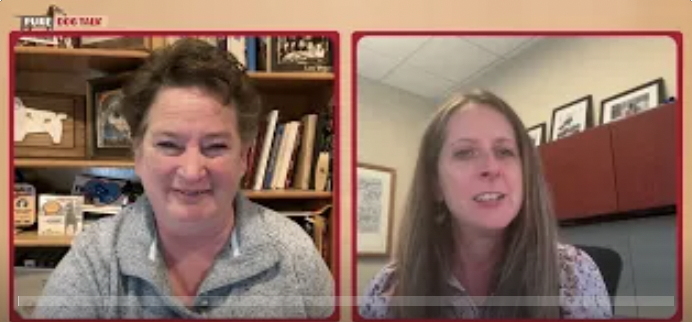 Stephanie Montgomery, CEO of the AKC Canine Health Foundation, joins host Laura Reeves to catch up on what the powerful non-profit has done and continues to do for all dogs.
Stephanie Montgomery, CEO of the AKC Canine Health Foundation, joins host Laura Reeves to catch up on what the powerful non-profit has done and continues to do for all dogs.
Montgomery, an Airedale fancier, joined CHF as the CEO in 2023, but “I was able to kind of blend my passion for science and dogs and started volunteering for the Canine Health Foundation as a scientific reviewer. And then I always say I’m a failed volunteer because now I’m working here.
“We are celebrating our 30th year anniversary this year, founded in 1995. And what I was so impressed by was that folks had this vision. So what we do is we fundraise, right? And we distribute that money. To fund the best research that will advance the health of all dogs. So we do that through awarding grants to researchers that tend to be at veterinary schools. And when we evaluate those grants, we wanna find the most cutting-edge research that’s going to have the biggest impact on dogs, and that’s what we’ve done for 30 years.
Canine Health Foundation helped fund the work conducted at Fred Hutchinson Cancer Center that identified the canine genome. This is the basis for all ensuing DNA testing since 2004.
“Prior to 1995 when CHF started, there was no dog genome,” Montgomery said. “The human genome had only been completed two years prior and it was pivotal. It changed the way that we could look at genetic testing and evolution of dogs and develop tools in veterinary medicine.
CHF’s contribution to ground breaking science continues to this day with research at hundreds of Universities, including studies into mitral valve disease that impacts millions of dogs.
“I’m so happy to see the work being done because mitral valve disease is so common in all of the dogs,” Montgomery noted. “I’m a pathologist and the number of older dogs that don’t have some mitral valve disease is really next to none. They all have it and we understand so little about it, even though it’s so common. And so I’m so excited that we have new studies going that help us understand the physiology of how this disease develops. It will help us identify targets for future therapies. We also have studies on how to best diagnose and monitor progression so maybe we can make a difference and impact all these dogs that have mitral valve disease.”
644 — Sheila Goffe On the CDC’s Importation Regulations
Sheila Goffe On the CDC’s Importation Regulations
Sheila Goffe, AKC Vice President of Government Relations, joins host Laura Reeves to discuss the CDC’s soon to be implemented rule about importing dogs into the US.
Goffe provides background on retail rescue as the impetus for CDC’s regulations, the work AKC, NAIA and other stake holders have provided to the CDC and the most recent update to the rule.
“CDC put out an announcement saying that they heard the concerns about the rabies certificate,” Goffe said. “Remember they had (originally) required that you had not only a rabies certificate, but a rabies from a USDA or Canadian accredited vet. So it’s not just like your regular vet. It’s like, OK, I have to go find basically the same vet I would go to if I’m importing a dog to another country.
“So that veterinarian-specific requirement, they have dropped that requirement. As of now, they’re saying that all you need to enter the United States with a dog from Canada or another low risk rabies free country is an import form. It’s now available online. You can fill it out online. It takes less than 10 minutes. You’re going to have a picture of your dog on it. You know, a little bit of information about you and an attestation that this dog has not been outside of a rabies free, low risk country for the last six months.
Dogs still need to be at least six months of age to enter the US from any country, Goffe added.
“Blame the irresponsible importers,” Goffe said, “because frankly, they claimed to be us. They claim to be personally owned dogs. And now CDC is saying we can’t tell the difference. So where we need to go with CDC is create a solution where we can say ‘we can tell you the difference, we can show you what we do that those folks would never be able to do. We can show you that this dog has been registered from a registered litter. You know, we can demonstrate this dog was at the vet at two days old getting dewclaws removed. I can prove to you this dog was here in this country and it has not gone to Azerbaijan and come back.”
Goffe encourages exhibitors and breeders to reach out to their representatives to share their concerns. Find resources HERE.
616 – Mary Dukes: An Evolution from Owner to Professional to Rep to Judge
Mary Dukes: An Evolution from Owner to Professional to Rep to Judge
Host Laura Reeves is joined by Mary Dukes, legendary Whippet breeder, professional handler, AKC Executive Field Representative and now judge.

A 1991 advertisement for Dukes’ handling services.
Dukes has spent a lifetime involved in working with animals. From showing horses to training elephants to showing dogs. Her work with the zoo animals instilled in her an absolute dedication to animal husbandry.
NO Dirty Dogs
“There are no shortcuts in animal care. Period,” Dukes said. “In zoo animals, you have to be even more on top of it because wild animals don’t have a tell that they’re sick. In the wild, any tell that they are sick or injured is going to make them dead. So they are really good at masking that. If you are sloppy or dirty or messy there is no room for you in the animal business.
“I’ll put this on blast right now, if someone walks into my ring with a dirty dog, we’re going to have a problem. There is no excuse to show a dirty dog. I won’t hold it against the dog, but the handler might get an earful.”
AKC Registered Handler Program
Dukes was an early member of the AKC Registered Handler Program. As a rep, Dukes was a coordinator of the RHP. She joined RHP because they demanded insurance, inspections, so “I wanted to put my money where my mouth was.”
RHP is not a guarantee the handler is going to win with your dog, Dukes said.
“The whole point of the program is so the people have a place to start looking where we had done some of the ground work for you. You know they (they handlers) are insured. You know their vehicle is inspected for safety and cleanliness. You know their kennel has been inspected by AKC kennel inspectors. You know they’ve signed a code of ethics.
“RHP members have to have a contract. They have to bill in a timely fashion. The bill has to be itemized. A lot of the trouble you see, most of it is because the expectations weren’t clear. If you have a contract, it’s
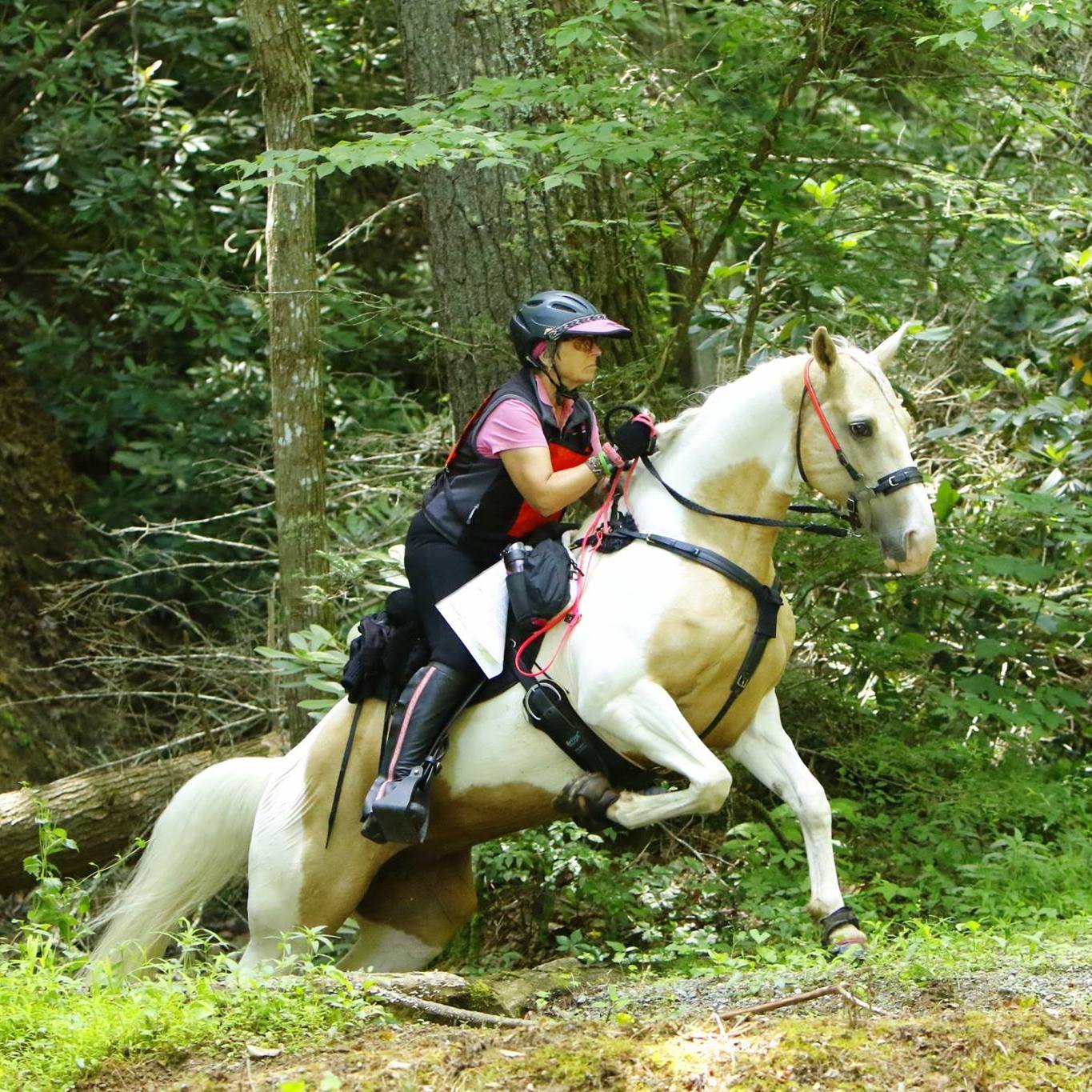
Dukes is still actively involved with horses. Her vacations frequently involve riding in exotic locales.
right there in black and white.
Safe Sport
“One of the newest requirements is SafeSport. All RHP members have to take the training as a condition of membership.
“Safe Sport is a congressionally mandated program for every Olympic sport.
“There’s been a lot of abuses in every sport. Basically, Safe Sport is making you aware of what to look for. If you see a situation that you suspect might be something, it gives you tools. Because we aren’t an Olympic sport, we don’t have access to the mechanics of the national organization.
“It automatically makes everyone (who’s had the training) mandatory reporters. If you put it out in the open more, it’s harder for someone to creep around. I would like to see it spread out to judges, especially juniors judges.”
Join us next week for part two of this fantastic conversation. Learn what Dukes is looking for in a dog and hear about her fantasy Best in Show lineup.
609 – Critiques, Communication and Common Sense in Dog Shows
Critiques, Communication and Common Sense in Dog Shows

Steve Dainard judging Spinoni back in the day, when Laura was still showing dogs.
Canadian Kennel Club judge Steve Dainard is back with host Laura Reeves for part two of a probing and thoughtful conversation about critiques, communication and common sense in dog shows.
“So we know that every rule and regulation that came in probably had a foundation in someone doing something wrong,” Dainard notes. “Judges need to keep their interactions in the ring, not be too conversational in nature. Well, then all of a sudden you’re going to get a whole population of judges who take us to the nth degree, and they’re even afraid to have any type of communication, apart from instructions to the exhibitor.
“So, I think there’s a fine line between having this full on getting caught up in the ring, but also having, an opportunity to be able to share meaningful dialogue. And I think that we can do that. I think that maybe we’re just not trained really well to do that. So maybe we need to have a discussion about what does that look like.
“I get it, writing written critiques or an oral critique or whatever can be scary for many people. People don’t like change, and whether it’s not because you don’t have the goods or you don’t know whatever, maybe that’s what the fear is based in. But I think culturally, you just hit the nail on the head, it’s not encouraged to have that dialogue, that communication, that interaction. And what it does, it creates silos within our sport. And this is not what we need. We need to be able to have a mechanism in place so that it’s okay to have a conversation.
“And that conversation doesn’t need to be precipitated by the fact that I’m pissed off because Laura didn’t put me up and I’m going to take a run at her after judging. And I got the rep coming with me because she crossed a line.
“Having a written critique foundation in your toolkit as the basis for how you’re trained to evaluate dogs creates a much easier conversation when that’s the way you’re programmed and how you’re picking your winners.
“I think that the fear of error is like, (exhibitors are) judging me, right? So I can see why people would be afraid of that until you get really good at it. And you have the conviction to be able to say, this is my process. I think it could be a little bit of an overwhelming concept, but the only way we rip that bandaid off is by diving in and starting to practice it.”
Listen to the full episode for insights on the role of judges in promoting responsible dog breeding and ownership and much more.
606 – Protecting Breeds Into the Future
Protecting Breeds Into the Future
Dr. Marty Greer, DVM joins host Laura Reeves to discuss AKC’s newest service for preservation breeders. Greer was actively involved in AKC’s development of the Purebred Preservation Bank, taking the idea from the Otterhound Club of America. We had the conversation with Joellen Gregory early on about the Otterhound’s semen bank, and AKC has taken this and developed it into something that’s available for all parent clubs.
“(PPB will allow) AKC to fund the long -term storage of semen that no longer has an owner that wants to manage it,” Greer said. “So, you don’t necessarily have to have passed away for this to happen. If you’re at the end of your breeding program and you’re sitting there with six beautiful dogs that have semen frozen, and you’re like, ‘Well, I don’t have anybody I’ve really mentored and my kids don’t want it, so where do I go with this?’
“That’s when you go to the AKC website, you pull up the information on there, you sign the document that allows AKC to take ownership. And once you hand it off, you no longer are in control of that part of the semen. You may send all of your dog’s semen, you may send part of that dog’s semen, you may send all the semen that you have to the AKC, and AKC will then pay for the long -term storage.
“Every breed club makes their own rules. Your parent club can put together their health committee, their genetics committee, a special committee for this. Your breed club will sit down and with some ideas from what other breed clubs have done, be able to say, ‘This is how we want the semen disseminated. Does the bitch have to have a CHIC number? Does she have to have these certain criteria? When is it appropriate to use? Has she had a litter before?’ All those kinds of things, your breed club can decide.
“But as you release the semen, you can’t say, ‘Well, I don’t like Susie Smith.” Susie Smith is never going to get to touch my semen ever, ever, as long as I live, over my dead body. Maybe it will be over your dead body because now it’s no longer yours.
“Fifty years from now and 100 years from now, that’s what we’re looking at. We’re not looking at what happens next Tuesday when a bitch has to be bred. We’re looking at 100 years from now. Is your dog still of value? You might say things like, ‘Well, styles of dogs change,’ and indeed they do. But sometimes those foundational dogs are structurally what you need. Sometimes those foundation dogs predate certain genetic disorders that have really worked their way deeply into the gene pool and could be very hard to breed your way out of.
“AKC’s role in this is to pay for the semen storage and to register the puppies. That’s it. AKC is not there to start saying, ‘Well, we want you to do this with this and we want you to do that with that. And you have to have faith that 100 years from now, this mission, this vision is going to be held true. But it’s not about Susie Smith. It’s not about you. It’s not about (any individual dog). It’s about the overall health of the breed and where we can go with some of the genetics.”
577 — Margery Good on the Deep Character of “Sillyham” Terriers
Margery Good on the Deep Character of Sealyham Terriers
Margery Good joins host Laura Reeves to share her deep love of her beloved Sealyham Terriers, breeding, grooming and the importance of learning.
Good started in obedience with a German Shepherd Dog.
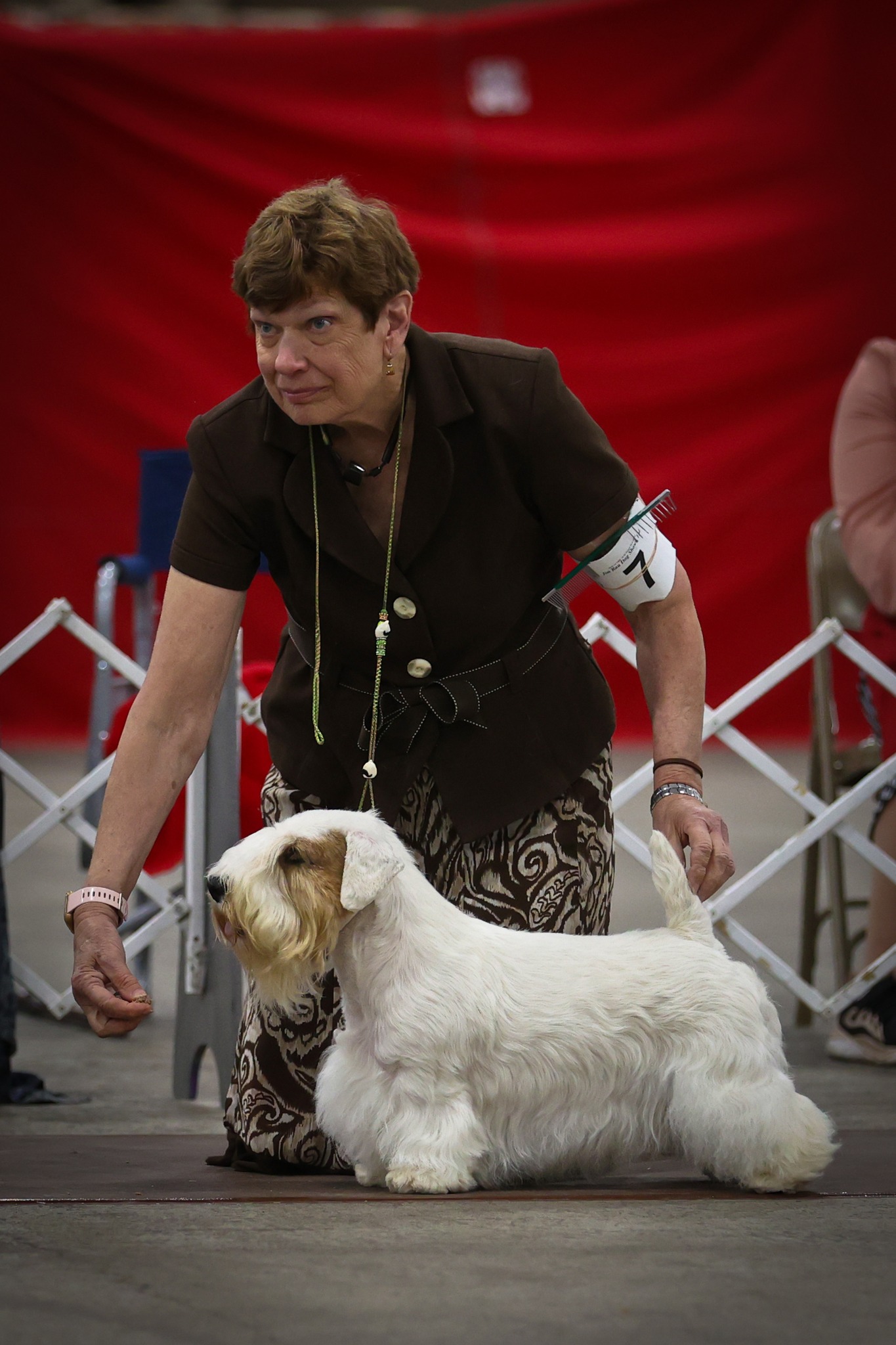
Margery Good with BIS/BISS CH Goodspice Efbe Money Stache
“I entered in obedience, but then I spent my day at the dog show stalking the handlers that were sharing their conformation dogs and trying to learn as much as I possibly could, without getting in their way. Peter Green, Bob and Jane Forsyth. Bill Trainor. People that were at the very top of their careers in those days, and I would spend as many hours as I could watching and trying to learn.
“Well, I watched a lot of their grooming at their setups and how they handled each dog on the tables and putting them on and off the table. how they brushed them, what direction they use or what tools they picked up. Except for the Forsyths, the handlers were only showing like 6-7 dogs in the show and they’d do some trimming the shows.
“So I’d watch how they tweak the trim before they take them in the ring. And then with like the Afghan hounds and Poodles I watched, how did they brush the hair? How did they pick up the hair they weren’t brushing so that they could get from their skin to the tip of the hair. So I picked up a lot of learning from observing how they prepared the dogs. And then I’d go and watch them actually showing the dog. I actually spent more time behind the scenes than by the rings.
Speaking to the challenge of trimming Sealys, Good said “I do try very hard to breed dogs with coats that normal groomers and average dog owners, if they apply themselves, they can work and have their successful finish to them. I also spend a lot of time helping people at shows or at my place or wherever I am to help them tidy up their trims and show them a new technique that they haven’t tried or encourage them to keep going until they get it right.
“Now that we have things like cell phones, I say take pictures, send me pictures, I will critique your trim. I work with people, they’re 12-15 hours away. If they send me pictures, I will help. And it works.
Sealyham Terriers – Generous, Big Dogs in Small Package
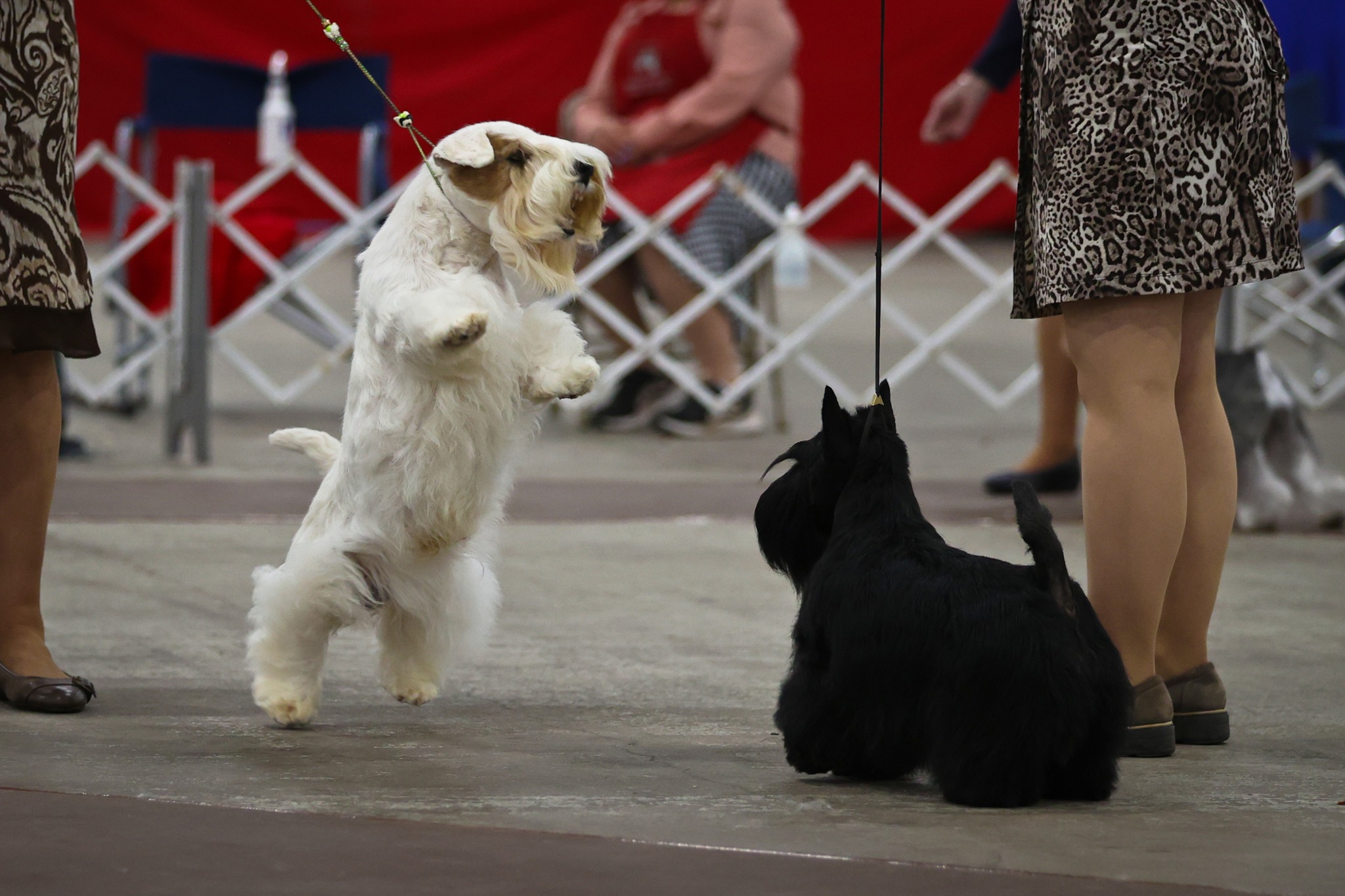
Stache sparring, showing the stand up character of the breed.
“They’re so generous. And all you need to do is ask and they will say what can I do for you. They’re very strong, sturdy, compact little dogs. They are big dogs just in a small package. They have very strong personalities. Their characters are very deep, as opposed to some of the other terrier breeds, whose characters are rather shallow. Which some people like. But it’s not for me. I like the depth of the character that I see in Sealyhams.
Classic Breeding Advice
“(Starting out) I was able to breed forward and not have a lot of faults that I had to breed away from. I had very good virtues to start with. In a breeding program, you need to concentrate virtues and minimize faults when you breed. So, you need to be able to see what a stud dog can give in virtues and what faults you might get and not double on what you have in your female. See what her strengths are and not double on the faults that they have. So, generation after generation, you do that. To the point of Stash, (GCHG CH Goodspice Efbe Money Stache, Terrier Group winner at the 2022 AKCNC) who’s the culmination of 50 years of my breeding.”
Listen to the entire conversation full of passion, insight and charm.
568 – AKC’s New Genetic Testing Program to Offer Expanded Insights
AKC’s New Genetic Testing Program to Offer Expanded Insights
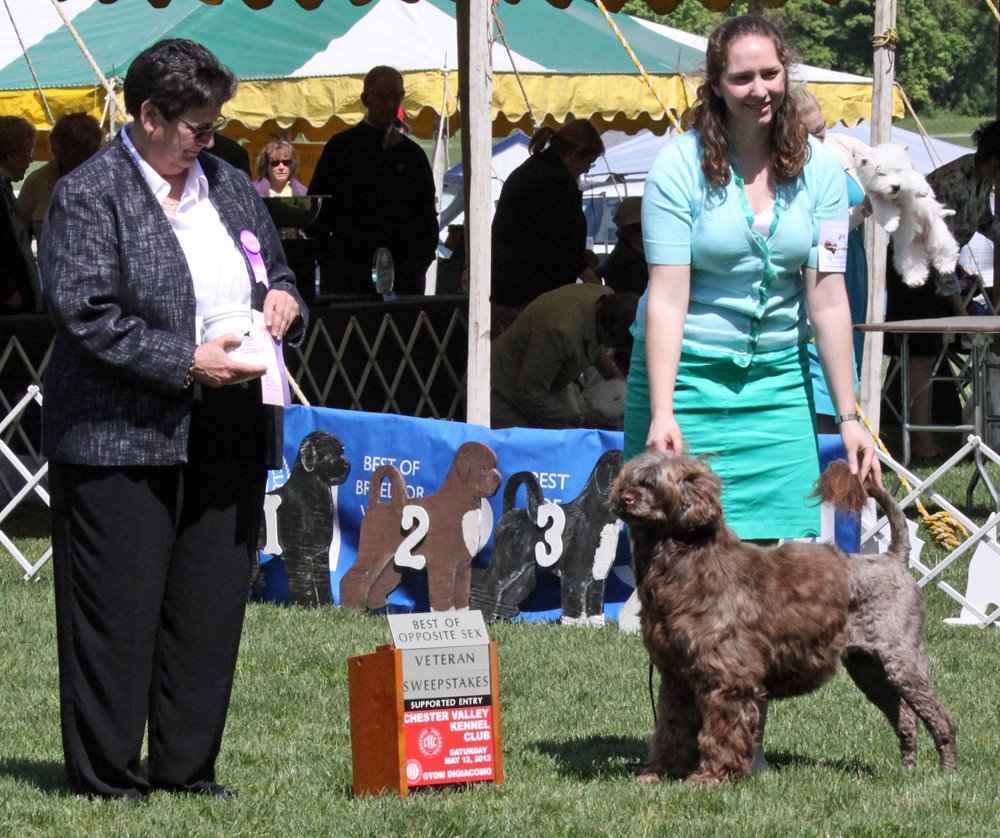
Dr. Claire Wiley, VMD and her Portugese Water Dog.
Dr. Claire Wiley, Executive Director of the AKC DNA Program, joins host Laura Reeves with breaking news about the expansion of their testing capabilities.
AKC’s DNA program will soon include the option to identify traits and genetic diseases, in addition to simple parentage, Wiley announced.
“For the past 25 years, the AKC DNA program has really focused on protecting the registry,” Wiley noted. “And they did that using unique identification, kind of like fingerprints and also using those fingerprints to verify parentage. It had more of a regulatory role to it.
“A couple years ago, the AKC developed an ad hoc genetics committee. They listened to the breeders (who) were really interested in having more from the DNA program. And that’s kind of why I got hired, because we’ve listened to the feedback and are trying to bring things into the future to really serve our most important constituents, the breeder.”
Wiley, a second-generation Portugese Water Dog breeder, is a board certified veterinary specialist in Small Animal Internal Medicine. Her passion for genetic health testing started early in life after losing two PWD puppies to juvenile dilated cardiomyopathy. She later worked on the breakthrough studies to identify the genetic marker for protein losing nephropathy in Soft Coated Wheaten Terriers.
“I’m a breeder. I lived through it from the very beginning and now I’m back here to help bring the DNA program into the future,” Wiley said. “At AKC, we try to focus on all dog owners, but it all starts with the breeders who are producing the healthy dogs for all dog owners.
“The fundamental process will essentially be the same where you use a cheek swab to collect DNA and you go online to activate it. When you first go in to buy the swabs, there will be two products. The original parentage product will be called the AKC Original DNA profile and then the one that includes health tests and traits will be called the AKC Signature DNA profile.
“So when you’re actually on what we call our shop page where you’re buying the swabs, you have an option of choosing either just the Original profile, which is the $50 kit that provides parentage, or you can choose the option that still includes that $50 original profile, but also has health and traits available.
“We’re really hoping to launch this by mid 2023 at the latest, hopefully April. A lot of these companies say there are over 200 markers that they’re testing for, but if you actually talk to breeders, they’re probably focused on 2, 3, maybe 0 for that specific breed. So, we are taking the experts, you know, the Breeders, and having them tell us what we should be including as important markers for them.
“The parent clubs have what we call parent club health statement letters where they actually say this is what we are concerned about as a breed and as a group, and so we’re using those letters to determine which testing is the most important for that breed.”
Listen to the full episode for more from Dr. Wiley.
487 — Cavanaugh on Collaboration, Change and Carrots
486 — Wayne Cavanaugh: the “Total Dog” Man
337 – Black & Tan Dynamos: The Wash & Wear Manchester
Black & Tan Dynamos: The Wash & Wear Manchester
The Manchester Terrier has two varieties, Standard and Toy, both descended from the extinct black and tan terrier, according to a panel of experts at the American Manchester Terrier Club National Specialty.
The Manchester’s job was to hunt rats and other vermin in England and they retain the high prey drive today. Our experts encourage new owners to be sure their Manchester is on lead when outside a fenced area.
“You can have a good recall, but a squirrel will always take precedence,” said Marla Zoz.
Key Manchester Points:
- High drive, are food motivated but easily distracted.
- Very smart, pick up new skills quickly.
- Get very attached to their people. Suitable for a house or apartment.
- Need lots of physical activity.
- Require a lot of attention.
- Love being a part of the family.
- Need to spend time to develop well balanced companion.
- Low maintenance grooming… nails, clean teeth, wash and wear.
- Longevity – 15+ years.
- Health issues include cardiomyopathy and vWD, a bleeding disorder. When visiting with a potential breeder, be sure to ask if he/she is testing for these conditions with available DNA tests.
Standard Manchester Terriers are allowed to have naturally erect ears, button (shown here) or cropped. Toy Manchesters are only shown with naturally erect ears.
“You want to go, they’re ready at a moment’s notice. You want to cuddle on the couch, they’re right there,” said Jim Burrows.
These dogs are terriers, whether standard or toy sized, our panelists noted. They can “talk a lot.” Everyone agreed that the “four-footed burglar alarm” breed can be vocal. “They’re going to bark if they see something they don’t know,” Burrows said.
While generally aloof with strangers, the Manchester will warm up to new folks quickly. The breed needs a lot of socializing to develop a well-rounded dog, the breeders all agreed. Dog aggression, typical of many terriers, is manageable with appropriate socializing and training.



